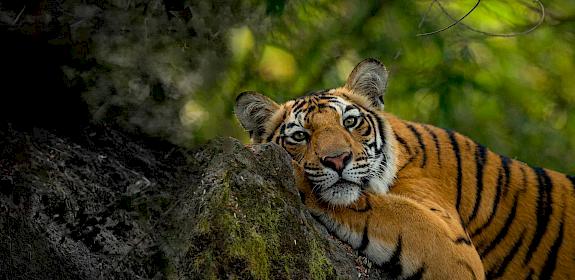Fifteen species at risk: World Wildlife Day 2014
Cambridge, UK, 3rd March 2014—World Wildlife Day, when the plight of 15 species threatened by overharvesting is highlighted.
01) Chinese Pangolin – Endangered © Jason S C Chin Taipei Zoo Program, Cuc Phuong
The Chinese Pangolin Manis pentadactyla is listed as Endangered On The IUCN Red List of Threatened Species. Chinese Pangolins are intensively hunted across most of their range for local use of its skin, scales and meat and illegal international trade. Observations in mainland Southeast Asia and East Asia indicate that there is very heavy unofficial, or at least unrecorded, international trade in pangolins and pangolin products, which evidence suggests is having a detrimental impact on this species. A protected species in almost all range states, the Chinese Pangolin is listed on Appendix II of the Convention for International Trade in Endangered Species (CITES).
02) Beluga Sturgeon – Endangered © Tony Gilbert
The Beluga Sturgeon Huso huso is listed as Endangered on The IUCN Red List of Threatened Species. Overfishing, habitat loss and pollution threaten the survival of the Beluga Sturgeon. Its eggs are highly prized as beluga caviar, and illegal fishing is reported to be common. Pollution, dams and silting can cause habitat destruction by damaging coastal waters and altering river courses. The majority of the Beluga Sturgeon population is now supported artificially, with hatcheries thought to be the sole reason the species still survives in the Caspian Sea. The United States is the biggest importer of beluga caviar, and has now listed the species as ‘Threatened’ under the Endangered Species Act, suspending imports.
03) Lydenburg Cycad – Critically Endangered © Drew Avery
The Lydenburg Cycad Encephalartos inopinus is listed as Critically Endangered on The IUCN Red List of Threatened Species. This species has suffered much from the activities of collectors and in addition, large troops of baboons damage immature cones and this could explain the absence of seedlings. Helicopter surveys show numbers dropping from 677 in 1992 to 113 in 2001 (83% decline) and to 81 plants in 2004 (further 28%). Stan Rogers (pers. comm.) from the Limpopo Provincial Government reported in 2006 that the species might be extinct in the wild as poaching had continued after 2004.
04) Paphiopedilum urbanianum – Critically Endangered © douneika
The Paphiopedilum urbanianum is listed as Critically Endangered on The IUCN Red List of Threatened Species. The species occurs only in Mindoro Island. Though the locality is a protected area, it is still exposed to human disturbance, i.e., logging, slash-and-burn, and expansion of settlement areas. The species is over-collected in the wild by local enthusiasts and in demand in the local and international trade.
05) Ploughshare Tortoise – Critically Endangered © Anders G.J. Rhodin
The Ploughshare Tortoise Astrochelys yniphora is listed as Critically Endangered on The IUCN Red List of Threatened Species. Restricted to a tiny area of dry scrubland in northwestern Madagascar, this species has received conservation attention since the early 1970s. Protection of the small population in its natural habitat and a captive breeding programme slowly began to increase its numbers, until it became a target of illegal international wildlife traders. Though strictly protected under Malagasy and CITES laws, unacceptable numbers of animals are smuggled and sold for huge sums by criminal pet dealers.
06) Bali Starling – Critically Endangered © Darren / whifflepeg
The Bali Starling Leucopsar rothschildi is listed as Critically Endangered on The IUCN Red List of Threatened Species. This stunning starling qualifies as Critically Endangered because it has an extremely small range and a tiny population which is still suffering from illegal poaching for the cagebird trade. Releases of captively bred birds have boosted the population, but it is uncertain how many of these have yet bred successfully in the wild. In due course, if the population continues to grow and trapping pressures can be brought under control, the species may warrant downlisting.
07) Chinese Giant Salamander – Critically Endangered © Michael Lau
The Chinese Giant Salamander Andrias davidianus is listed as Critically Endangered on The IUCN Red List of Threatened Species. This once common species has suffered a drastic population decline largely due to overharvesting (it is now considered to be a luxury food). Furthermore, their habitat has suffered from the construction of dams, local pesticides, fertilizers and pollutants. Although this species is commercially farmed, wild individuals still suffer from heavy collecting pressure because of their high value for food and as new stock for breeding farms. Many Chinese Giant Salamanders are produced in commercial breeding farms yearly and a small number of captive-bred individuals have been released back to the wild.
SOS - Save Our Species funded a project preventing the spread of disease to wild populations and to reduce the harvesting of wild individuals.
http://www.sospecies.org/sos_projects/pilot_projects/edge_of_existence/chinese_giant_salamander/
08) African Elephant – Vulnerable © Alicia Wirz
The African Elephant Loxodonta africana is listed as Vulnerable on the IUCN Red List of Threatened Species. Historically, poaching for ivory and meat has been the main cause of the African Elephant’s decline. While populations in Central Africa have in the past been the most at risk from poaching and the ivory trade, previously secure populations in Eastern and Southern Africa are now facing an increasing threat from illegal killing. Land conversion and loss of habitat, which has increased the incidence of human-elephant conflict, also continue to severely threaten this species across its range. The African Elephant receives various degrees of legal protection throughout its range, and international trade in elephant ivory is controlled
SOS – Save Our Species has funded two t conservation projects to protect elephants in Mali and Cameroon from increased risks of poaching. under the Convention for International Trade in Endangered Species (CITES). http://www.sospecies.org/sos_projects/mammals/african_elephant_and_west_african_lion/
09) Tiger – Endangered © Alex Sliwa
The Tiger Panthera tigris is listed as Endangered on the IUCN Red List of Threatened Species. The Caspian, Javan and Bali Tigers are already extinct, and of the remaining six subspecies, the South China Tiger has not been observed for many years. Poaching and illegal killing are major threats due to the growing demand for their bones for use in traditional Asian medicine. In India, as many as 50% of Tiger deaths in protected areas alone are due to poaching. Other severe threats include habitat loss, and overhunting. Over the past century, tiger numbers have fallen from about 100,000 individuals to an estimated 3,500.
SOS- Save Our Species has funded several conservation projects on tigers engaging local communities and individuals. http://www.sospecies.org/sos_projects/mammals/tigers2/
10) Burmese Python – Vulnerable © Mark Auliya
The Burmese Python Python bivittatus is listed as Vulnerable on The IUCN Red List of Threatened Species. This species is under threat due to illegal trade; in China it has been heavily impacted by overexploitation for food and skins, the latter for use both in leather and in traditional musical instruments such as Erheen, Sanxian and hand drums (CITES 2011) and Vietnamese populations are under pressure from a combination of use in food and leather production, export to supply the pet trade, and consumption in snake wine. Ironically, this is an invasive species that is firmly established in southern Florida, USA, and poses a threat to the ecosystem there by consuming native wildlife.
11) Black rhinoceros – Critically Endangered © Sue Mainka
The Black rhinoceros Diceros bicornis is listed as Critically Endangered on The IUCN Red List of Threatened Species. Between 1970 and 1992, the Black Rhino suffered a 96% reduction in numbers, with total numbers dipping as low as around 2,400. The increase in poaching has arisen from the escalating demand in the use of rhino horn in Asia (for non-traditional medicinal use, especially in Viet Nam). Other threats include habitat changes, competing species and alien plant invasions. The recovery of Black Rhino populations has been largely due to their effective protection and the translocation of surplus rhinos to re-establish viable populations within their former range. However, decades of highly successful conservation work are threatened to be undone by the current rhino poaching wave sweeping southern Africa to supply rhino horns to Asian markets.
SOS – Save Our Species has funded a project supported the ongoing protection of Namibia’s unique desert Black Rhinos from increased risk of poaching
http://www.sospecies.org/sos_projects/mammals/blackrhino/
12) Giant Armadillo – Vulnerable © Carly Vynne
The Giant Armadillo Priodontes maximus is listed as Vulnerable on The IUCN Red List of Threatened Species. Although still widespread, the Giant Armadillo is patchily distributed and locally rare, and its population is undergoing a decline. The main threat to the species is hunting for its meat, which is compounded by habitat loss from deforestation. Giant Armadillos are also illegally caught to be sold to animal collectors on the black market, but usually die during transport or whilst in captivity. The Giant Armadillo occurs in a number of protected areas, and international trade in the species is banned by its listing on Appendix I of CITES.
13) Oceanic Whitetip – Vulnerable © Jeremy Stafford-Deitsch
The Oceanic Whitetip Carcharhinus longimanus is listed as Vulnerable on The IUCN Red List of Threatened Species. The Oceanic Whitetip Shark suffers from fishing pressure throughout most of its geographic range, with large numbers being caught as by-catch in pelagic fisheries. The shark’s large fins are highly prized in international trade, being sold to the Far East to make shark fin soup. Although classified as Vulnerable overall, this species has been assessed as Critically Endangered in the Northwest and Western Central Atlantic, as a result of massive population declines due to by-catch in tuna and billfish fisheries.
14) Cowan's Mantella – Critically Endangered © Franco Andreone
The Cowan's Mantella Mantella cowanii is listed as Critically Endangered on The IUCN Red List of Threatened Species. Listed as Critically Endangered because its Area of Occupancy is probably less than 10km2, its distribution is severely fragmented, and the extent of its habitat is probably declining; and also because of a drastic population decline, estimated to be more than 80% over the last three generations, inferred from observed shrinkage in distribution and declines in the number of mature individuals, anecdotal information on habitat destruction and/or degradation, and from levels of exploitation inferred from the numbers of animals in international trade.
15) Elegance Coral - Vulnerable © Tim Wijgerde
Elegance Coral Catalaphyllia jardinei is listed as ‘Vulnerable’ on the IUCN Red List of Threatened Species. This coral is found as individual polyps or in colonies settled loosely in depressions in the sand, from parts of East Africa, to Asia and Australia. Over-harvesting for the aquarium market is the biggest threat to this species and, like all corals, it is also threatened by coral bleaching and ocean acidification, both caused by climate change. Destructive fishing, pollution and coastal development also threaten corals. Elegance Coral is listed on Appendix II of CITES, which makes it an offence to trade it internationally without a permit. However, quotas on the trade of this species may not be sufficient.



